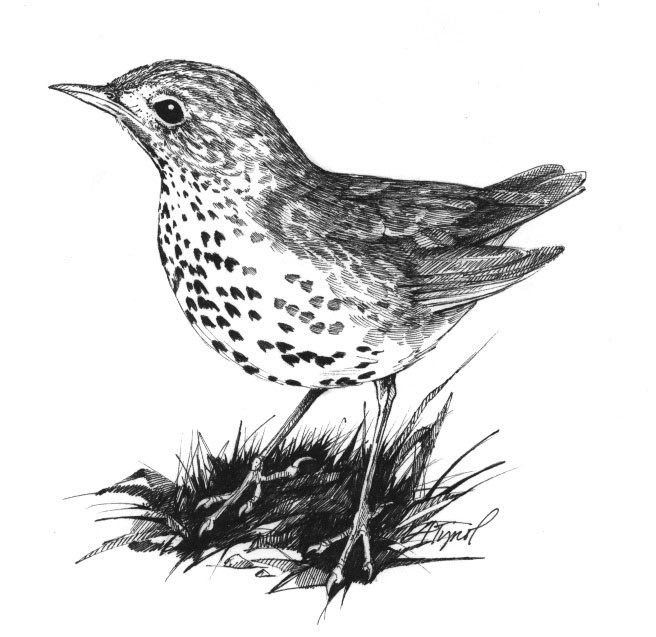
Spring mornings and evenings at my family’s cabin in the woods of Waitsfield, Vermont, are charmed by the ghostly, flute-like song of the wood thrush. In recent years, however, wood thrush populations in the Northeast have declined, and their magical song has begun to fade. What could be happening to the habitat around our cabin that threatens these familiar forest-dwellers?
Returning each spring from its winter range in Central America, the wood thrush chooses its breeding ground in hardwood and mixed forests through the northeastern U.S. and southeastern Canada. As a rule, the forest habitat best suited to wood thrushes has plenty of shade, a convenient source of water, and an open forest floor carpeted by leaf litter. Each pair of birds will defend a territory ranging in size from less than an acre to as much as two acres, building a robin-sized nest of dead grasses and leaves in the fork of a tree branch usually above human head-height.
Wood thrushes spend much of their time on the forest floor, combing through leaf litter for beetles, caterpillars, and millipedes to provide them the energy they need to raise their young. Typically, they produce one or two broods each season. For the egg-laying female, a diet of mostly insects necessitates a calcium supplement of sorts to ensure healthy egg shells. For the wood thrush, this often comes in the form of calcium-rich gastropods such as snails and slugs.
As it turns out, the need for a diet high in calcium may be a key factor in the fate of the wood thrush and possibly many other song bird species as well.
Songbird population declines have long been tied to forest fragmentation, as trees are felled to make way for human development throughout the birds’ breeding territories. Forest fragmentation also provides easier access to these breeding territories for such predators as raccoons, who feed on the nest eggs. But a recent study by ecologists at the Cornell Laboratory of Ornithology has implicated yet another culprit in the decline of the wood thrush. Intending to explore the effects of forest fragmentation on the wood thrush, the scientists were surprised to find a new factor in the equation: acid rain.
A byproduct of burning fossil fuels for our vast energy needs, acid rain occurs when nitric and sulfuric acids combine with water in the atmosphere and return to earth as rain, snow, or mist. Acid reaction with the ground depletes soil calcium levels, leading to a host of forest ills.
In the early 1980s, Vermont then-Governor Madeleine Kunin made a well-publicized trip to Camel’s Hump to underscore the problem of acid rain in the Northeast. Calcium-depleted soil on the mountainside had left the trees unable to protect themselves against the stresses of temperature and insects, and the entire red spruce forest was in trouble.
Today, the wood thrushes near my Waitsfield cabin, which has a magnificent view of Camel’s Hump and its dying trees, are also feeling the effects of more than a half century of acid rain.
According to the Cornell study, wood thrush numbers in the eastern U.S. have declined by more than forty percent since 1980. The steepest declines have occurred in areas with the heaviest acid rainfall, especially in elevated forests along the spine of the Appalachians. In the northern forest, significant wood thrush population declines have been recorded in the Adirondacks, the Greens, and the White Mountain ranges.
The study notes that a female songbird needs nearly 15 times more calcium to produce her eggs than a mammal of similar size needs to nurture its embryos. With such a demand, she relies on a steady supply of snails and slugs gleaned from the forest floor. Healthy gastropods, in turn, rely on adequate calcium levels in the soil. Where soil acidity is greatest, snails and slugs do poorly. In a classic case of the interdependence of different animals along the food chain, as the snail goes, so goes the wood thrush.
A calcium-poor diet can easily lead to egg shell defects and a smaller clutch of eggs. Both of these factors may contribute to breeding failure not only for the wood thrush but also for a variety of other songbirds.
The Cornell scientists wrote: “Despite clean air legislation, many eastern regions continue to experience heavy, wet, acidic deposition, and many bird species breeding in these areas show unexplained population declines.”
With our culture ever-more dependent on the fossil fuels that lead to acid rain, it seems likely that springtime at our Waitsfield cabin is likely to become even quieter as wood thrush songs become rarer still. The Cornell study, at least, deepens our understanding of the Northeast’s ecosystem and may yet help us make the right decisions to protect what is surely a delicate balance.


Discussion *